I had so much fun with my phone gimbal I decided to buy a gimbal for my m4:3 cameras. Specifically the G9 with the Pan/Leica 12-60mm on the front. I chose the Zhiyun Crane V2 because it was well reviewed and cheap. Really cheap. But I guess that's typically the case on past tense products. I know that newer gimbals have more options, can be driven to do more things with smart phones, and have programmable modes but for right now my gimbal needs are simple and I'd rather learn a few things in depth than tons of things in a shallow way. If my needs change I'm pretty sure there's always going to be gimbals out there to upgrade to.
I'm shooting easy stuff today. The road up to the state capitol building. Some static shots of the lake with the sky in the background. Some landmarks. Joggers on the train. Signage at Barton Springs. And anything else that catches my eye. My real mission is to understand and comfortable with shooting the G9 + gimbal combo and learning the basics. I always think of things in terms of swimming so in my terminology this is doing drills. Drilling the basic moves into my brain.
Swimming. It's nice to be back on a later schedule. There's something disturbing about getting up super early in the morning and hitting the water while the sky is still deep black. I did the 8:00 a.m. workout today and to be honest I really dogged the whole thing. I worked on technique. I reveled in slow flip turns. I did a lot of backstroke so I could watch flocks of birds fly over head. I doubt I got in more than 2800 yards but it all felt so good. The water (amazingly!!!) is right at 80 degrees, which is five degrees cooler than the water coming out of my garden hose. Perfect to swim in and a very, very refreshing way to start a day that's destined for heat indexes that are scary. I need one more workout like this before Saturday's shoot...
Hurricane news. It sure looks like Louisiana got hammered today by Hurricane Laura. All our hotels are full of weather refuges and the city has also opened the Circuit of the Americas (F1) racing compound to temporarily house the flood of people who fled the storms. It's a good time to make donations to the Capitol Area Food Bank and any other helpful charity you might like.
Kitchen news. Our leak was fixed by an incredible plumber named, Herman. He dropped by and replaced two 25 year old valves with better, brand new ones and the total cost for his house call and same day service, including parts was $120. I went out to the studio, rounded up all the rest of my (non-camera essential) tools and put them on the front curb with a sign that reads, "free tools." I'll never bust a knuckle again.
Camera news. You know that Canon must have received an overwhelming flood of criticism about the overheating issues with their two new cameras because they've already gotten out the fastest firmware upgrade in the history of camera marketing. I think most of it just resets the clock in the cameras that timed out the unit and blamed it on temperature regardless of actual temperature readings. I hope people who review cameras will take the new firmware into consideration.
I'm patiently (?) waiting to see if Panasonic will introduce the three lenses I've been waiting on along with the upcoming S5 camera body. The lenses are supposed to be the 24, 50 and 85mm f1.8s. My hope is that they'll be small, sharp and less than half the price of the current S-Pro juggernauts. I love the results of the current lenses but would love lighter lenses for those times when you just want to include a camera on a lighthearted hike.
Tomorrow will be a day of mellowness in preparation for Saturday's marathon movie-making. More to follow....
Hoping your studio is A Clean, Well Lighted Place.














